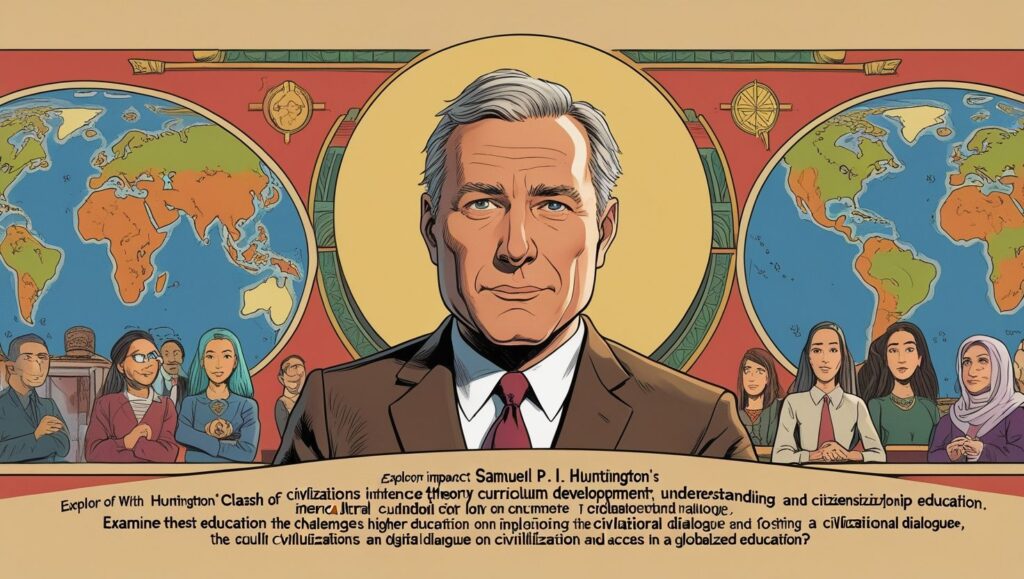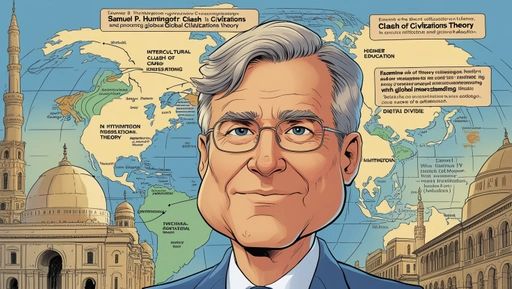Introduction
The Impact of the Clash of Civilizations Theory on Modern Education, The “Clash of Civilizations” theory, proposed by political scientist Samuel P. Huntington in the 1990s, has had a profound influence on global political discourse. Huntington argued that future conflicts would not be primarily ideological or economic but rather cultural, with the world’s major civilizations—Western, Islamic, Sinic, Hindu, Orthodox, Latin American, and African—competing for dominance. While the theory has been widely debated and criticized, its implications extend beyond geopolitics into the realm of education. Modern education systems, which are increasingly globalized and interconnected, have been shaped by the ideas and tensions highlighted in Huntington’s theory. This article explores the impact of the Clash of Civilizations theory on modern education, focusing on curriculum development, intercultural understanding, and the role of education in fostering global citizenship.
1. Curriculum Development: Emphasizing Cultural Identity
One of the most significant impacts of the Clash of Civilizations theory on modern education is its influence on curriculum development. Huntington’s emphasis on cultural identity as a defining feature of civilizations has led many educational systems to prioritize the teaching of cultural heritage and history. In response to the perceived threat of cultural homogenization, particularly from Western influences, many countries have revised their curricula to emphasize local traditions, languages, and values.
For example, in countries with strong Islamic traditions, such as Saudi Arabia and Iran, educational curricula often include extensive instruction in Islamic studies, Arabic language, and the history of Islamic civilization. Similarly, in China, the government has promoted the teaching of Confucian values and Chinese history as a way to reinforce national identity and resist Western cultural influences. This focus on cultural identity in education can be seen as a direct response to Huntington’s assertion that civilizations will seek to preserve their distinctiveness in an increasingly interconnected world.
However, this emphasis on cultural identity in education has also led to criticism. Some argue that it can result in a narrow, insular view of the world, limiting students’ exposure to diverse perspectives and hindering their ability to engage with global issues. In extreme cases, it can even contribute to the perpetuation of stereotypes and prejudices, reinforcing the very divisions that Huntington’s theory predicts.
2. Intercultural Understanding: Bridging the Divide
While the Clash of Civilizations theory has led some educational systems to emphasize cultural identity, it has also spurred efforts to promote intercultural understanding and dialogue. Recognizing the potential for cultural conflicts, many educators and policymakers have sought to develop programs that foster mutual respect and cooperation among different civilizations.
One example of this is the growing emphasis on multicultural education in Western countries. In the United States, Canada, and Europe, schools have increasingly incorporated multicultural perspectives into their curricula, teaching students about the histories, cultures, and contributions of various ethnic and religious groups. This approach aims to counteract the divisive effects of cultural differences by promoting empathy, tolerance, and a sense of shared humanity.
Similarly, international education programs, such as student exchange initiatives and global citizenship education, have gained prominence in recent years. These programs seek to break down cultural barriers by providing students with opportunities to interact with peers from different civilizations, learn about their cultures, and develop a global perspective. Organizations like UNESCO have also played a key role in promoting intercultural dialogue through education, advocating for the inclusion of global citizenship education in national curricula.
Despite these efforts, challenges remain in achieving meaningful intercultural understanding. The persistence of cultural stereotypes, language barriers, and unequal access to educational opportunities can hinder the effectiveness of these initiatives. Moreover, the rise of nationalism and populism in many parts of the world has led to a backlash against multiculturalism, with some arguing that it undermines national identity and cohesion.

3. The Role of Education in Fostering Global Citizenship
The Clash of Civilizations theory has also influenced discussions about the role of education in fostering global citizenship. In a world where cultural differences are seen as a potential source of conflict, education is increasingly viewed as a tool for promoting peace, cooperation, and sustainable development.
Global citizenship education (GCE) is an approach that seeks to equip students with the knowledge, skills, and values needed to address global challenges, such as climate change, poverty, and inequality. GCE emphasizes the interconnectedness of the world and encourages students to think critically about their roles and responsibilities as global citizens. This approach aligns with the idea that education can play a key role in bridging cultural divides and promoting a sense of shared humanity.
However, the implementation of GCE is not without its challenges. In some cases, the emphasis on global citizenship has been criticized for being too abstract or idealistic, failing to address the real-world complexities of cultural and political conflicts. Additionally, there is often a tension between the goals of GCE and the need to preserve cultural identity, as discussed earlier. Striking a balance between these two objectives is a key challenge for educators and policymakers.
4. The Digital Divide and Access to Education
Another important aspect of the impact of the Clash of Civilizations theory on modern education is the issue of access to education, particularly in the context of the digital divide. Huntington’s theory highlights the disparities between civilizations in terms of economic development, technological advancement, and political power. These disparities are reflected in the unequal access to educational resources and opportunities, both within and between civilizations.
The digital divide—the gap between those who have access to digital technologies and those who do not—has become a critical issue in modern education. In many parts of the world, particularly in developing countries, students lack access to the internet, computers, and other digital tools that are essential for participating in modern education. This digital divide exacerbates existing inequalities and limits the ability of students from less developed civilizations to compete on a global scale.
Efforts to bridge the digital divide have included initiatives to provide affordable internet access, distribute digital devices, and develop online educational resources. However, these efforts are often hampered by economic, political, and infrastructural challenges. Moreover, the rapid pace of technological change means that the digital divide is a moving target, requiring ongoing efforts to ensure that all students have access to the tools they need to succeed in the 21st century.
5. The Role of Higher Education in Shaping Civilizational Dialogue
Higher education institutions play a crucial role in shaping the dialogue between civilizations. Universities and colleges are often at the forefront of research and scholarship on cultural, historical, and political issues, and they serve as important platforms for intercultural exchange and collaboration.
In recent years, there has been a growing emphasis on internationalization in higher education, with universities seeking to attract students and faculty from diverse cultural backgrounds. This trend reflects the recognition that higher education has a key role to play in fostering understanding and cooperation between civilizations. Programs such as international joint degrees, study abroad opportunities, and research partnerships are examples of how higher education institutions are working to promote cross-cultural dialogue.
At the same time, higher education is not immune to the tensions and conflicts highlighted by the Clash of Civilizations theory. Issues such as academic freedom, censorship, and the politicization of education can create challenges for universities seeking to promote open and inclusive dialogue. Moreover, the increasing commercialization of higher education has led to concerns about the commodification of knowledge and the marginalization of certain cultural perspectives.
Conclusion
The Clash of Civilizations theory has had a significant impact on modern education, shaping curriculum development, intercultural understanding, and the role of education in fostering global citizenship. While the theory has led to important efforts to preserve cultural identity and promote intercultural dialogue, it has also highlighted the challenges of navigating cultural differences in an increasingly interconnected world.
As education systems continue to evolve in response to the complexities of the 21st century, it is essential to strike a balance between preserving cultural identity and promoting global citizenship. This requires a commitment to inclusive and equitable education that recognizes the value of diversity while also fostering a sense of shared humanity. By addressing the challenges posed by the Clash of Civilizations theory, education can play a key role in building a more peaceful and cooperative world.

4 thoughts on “The Impact of the Clash of Civilizations Theory on Modern Education”
Comments are closed.